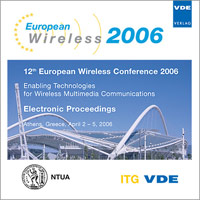An Adaptive MAC (A-MAC) Protocol Guaranteeing Network Lifetime for Wireless Sensor Networks
Conference: European Wireless 2006 - 12th European Wireless Conference 2006 - Enabling Technologies for Wireless Multimedia Communications
04/02/2006 - 04/05/2006 at Athens, Greece
Proceedings: European Wireless 2006
Pages: 7Language: englishTyp: PDF
Personal VDE Members are entitled to a 10% discount on this title
Authors:
Nam, Yongsub; Lee, Hojin; Jung, Hakyung; Kwon, Taekyoung; Choi, Yanghee (School of Computer Science and Engineering, Seoul National University)
Abstract:
Wireless sensor networks (WSNs) have a wide range of potential applications, a majority of which may be required to survive for a pre-configured lifetime since it is hard or costly to re-deploy sensor nodes to where a sensing hole has taken place. A sensing hole may occur when specific nodes suffer more traffic load than others and thus exhaust initially supplied energy. We propose an adaptive MAC (A-MAC) protocol for WSNs to tackle the sensing hole problem, which keeps the entire network operating for a required lifetime. The main concern in designing A-MAC is two-folded: guaranteeing the pre-configured network lifetime, and reducing end-to-end latency. In order to achieve both goals, A-MAC introduces an adaptive duty cycle depending on ratio of the remaining energy to the initially supplied energy considering the pre-configured lifetime. The more energy a node has, the more frequently the node will wake up and hence fasten relaying data. As a consequence, each node is expected to run out of energy around the end of the pre-configured network lifetime. Also, nodes with more energy are utilized to reduce the end-to-end delay. Simulation results exhibit significantly lower latency of A-MAC while guaranteeing the pre-configured network lifetime.


